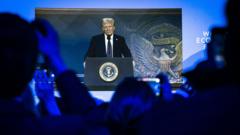Former President Jimmy Carter, who passed away at 100, played a vital role in a significant nuclear accident cleanup in Canada.
Jimmy Carter: A Legacy of Leadership and Nuclear Safety

Jimmy Carter: A Legacy of Leadership and Nuclear Safety
Remembering the 39th President's role in the Chalk River nuclear incident
In a week filled with reflections on the legacy of former President Jimmy Carter following his passing at the age of 100, significant historical insights emerged, particularly regarding his involvement in a major nuclear incident in Canada. The New York Times published a comprehensive visual representation of Carter's life, showcasing various objects that reflect his journey, including a largely forgotten nuclear accident that occurred in Chalk River, Ontario in 1952.
Among the highlighted artifacts was a certificate from the Knolls Atomic Power Laboratory, documenting Carter's completion of training as an "atomic submariner" during his early naval career. After serving in the submarine fleet during World War II and graduating from the U.S. Naval Academy, he became instrumental in developing the nation’s first fleet of nuclear-powered submarines. His experience in this realm would later lead him to assist with the cleanup efforts following the partial meltdown of the reactor near Ottawa.
Carter’s commitment to nuclear safety, evident even before his presidency, epitomized his leadership style—where he prioritized not just the well-being of the United States but also acknowledged the broader implications of nuclear technology on international safety. His actions during this crisis serve as a testament to his enduring legacy in the field of nuclear safety and environmental stewardship, underscoring the impact he had long before assuming the presidency.
Among the highlighted artifacts was a certificate from the Knolls Atomic Power Laboratory, documenting Carter's completion of training as an "atomic submariner" during his early naval career. After serving in the submarine fleet during World War II and graduating from the U.S. Naval Academy, he became instrumental in developing the nation’s first fleet of nuclear-powered submarines. His experience in this realm would later lead him to assist with the cleanup efforts following the partial meltdown of the reactor near Ottawa.
Carter’s commitment to nuclear safety, evident even before his presidency, epitomized his leadership style—where he prioritized not just the well-being of the United States but also acknowledged the broader implications of nuclear technology on international safety. His actions during this crisis serve as a testament to his enduring legacy in the field of nuclear safety and environmental stewardship, underscoring the impact he had long before assuming the presidency.























